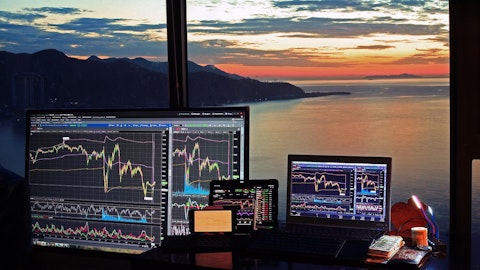Operator: Thank you. Our next question comes in line of Arun Viswanathan with RBC Capital Markets. Please proceed with your question.
Arun Viswanathan: Great. Thanks for taking my question. Maybe I’ll just ask a similar kind of question on the price mix. Very, very strong performance in Q1, 19%. And conversely, you had the 11% volume decline. So, was this kind of by design that you were maybe calling some lower margin, lower mix volumes and that drove an overall better mix and better margin for you? How should we think about how volumes kind of trend through the year? Maybe do they turn positive in Q4? And similarly, maybe your price mix wanes as we get into Q2 and Q3, just not only mainly mathematically, but maybe you can just comment on your outlook for both price mix and volume as you go through the year.
Andy Tometich: Sure. Thanks, Arun. As we’ve talked about in previous sessions, our value-based pricing is focusing on the value that we’re providing for our customers. And we realized that there could be some small amounts of business that may not be as high value to the customers. And so, as we’ve been strategically targeting our price initiatives, we knew that there was likely going to be some amount of volume churn, but we were very careful not to be reckless. And we felt a little bit of churn is actually healthy. That’s essentially what we’ve done, and we’ve seen a little bit of that wrap effect as we’ve come into some of the volumes in this year. As we go forward, we’ll continue to focus on that value-based pricing, taking into account, of course, the cost to serve it, kind of being agile and managing against those two things so that we continue to maintain and grow our gross margins as we go forward.
And then on the underlying volume side, as I mentioned, we have some optimism that there could be some growth on those underlying volumes, and we know we’re continuing to win new business at much more profitable levels, and we’re going to continue that focus on new business wins.
Arun Viswanathan: Okay. And just to clarify, though, what would it take to really see volumes kind of back in the, say low to mid-single-digit range? Is that really dependent on a better environment in metalworking and steel, or is it an aluminum, or is it China and regionally-based recovery, and a better Europe macro environment? What are some of the drivers that maybe that are not under your control that need to improve for the volumes to get to a sustainably better place?
Andy Tometich: Yes, Arun, I’d start right with the part we can control, and that is the new business wins. And as I’ve highlighted in previous quarterly earnings calls, we continue to gain new business based on the value we’re offering to our customers, and that will continue. The challenge that has been here has been in some of the underlying markets we’ve served for the last couple of years. Several of those are still not at their historic levels. We’re optimistic that those will come with time. Automotive, aerospace, some of the primary metals and general industrials still have ample opportunity to be at higher levels. So, as that continues to develop, we’re in a really good position to be able to service it.
Arun Viswanathan: Thanks. And just one more for me. So, you’ve talked in the past, I think around the upper teens or mid to high teens as the EBITDA margin target. Is that still how you’re thinking? And when you look into maybe is that kind of achievable in ‘24? Already well on your way to that metric in Q1 here, but maybe you get into the 16% to 18% range in ‘24. Is that a fair assumption?




